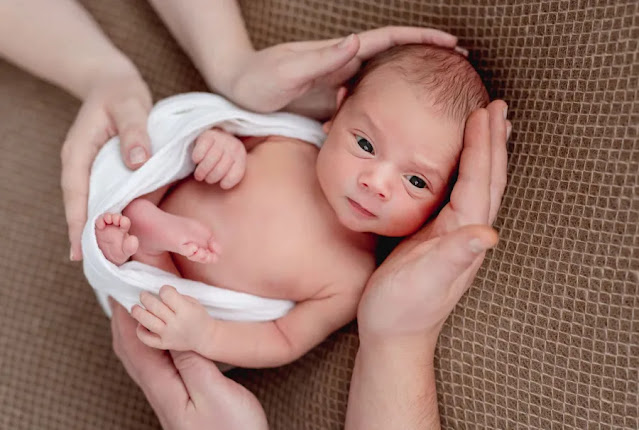Did you know that infections, including umbilical cord infections, contribute to about 21% of neonatal deaths worldwide, according to UNICEF? This alarming statistic highlights the importance of proper umbilical cord care to ensure your newborn's health.
Scientifically, the umbilical cord is the vital connection between the mother and the fetus during pregnancy. After birth, it becomes a dry stump that falls off within a few days. However, neglect or improper care can lead to severe complications. In this article, Dr. Mahmoud Al-Azaby, a pediatric specialist, outlines five simple steps to ensure proper care of the umbilical cord for newborns.
1. Keep the Umbilical Cord Clean and Dry
Proper care for the umbilical cord is simple but requires careful attention to ensure quick and healthy healing. The primary steps include:
- Keep the cord clean and dry. There’s no need for strong antiseptics. According to recent recommendations, clean the base of the umbilical cord with warm water and soap only when necessary, then dry it thoroughly.
- Use a clean cotton ball or sterile gauze to avoid excess moisture.
- Avoid touching the cord with dirty hands or allowing the baby to frequently touch the area.
- Clean the cord immediately if it gets soiled with urine or stool using a cotton ball soaked in warm water, then gently dry it. Avoid using harsh products or antiseptics as they may dry out the skin and cause irritation.
(The drier and cleaner the umbilical cord, the faster it will fall off and the less likely it is to become infected.)
2. Avoid Submerging the Baby in Water
It’s important to avoid bathing your baby in water until the umbilical cord stump falls off, which typically takes between 5 to 15 days. Instead, use a sponge bath to keep the area dry. This will help speed up the healing process and prevent infections.
- Use a soft, damp towel to gently clean your baby’s body, making sure to avoid wetting the umbilical area.
- After cleaning, dry your baby thoroughly using a soft cotton towel, especially around the belly button area.
- Dress your baby in loose, cotton clothes that allow for air circulation, which helps the umbilical cord dry faster.
When changing the diaper, make sure the umbilical stump is not covered, as this can trap moisture and increase the risk of infection.
3. Watch for Signs of Infection
Although umbilical cord infections are rare, parents should stay vigilant for any abnormal symptoms, such as:
- Yellow discharge with a foul odor from the umbilical cord.
- Redness or swelling around the cord area.
- Crying when the area is touched.
If you notice any of these symptoms, it’s important to consult your doctor immediately to prevent complications. Also, monitor for any unusual changes such as light bleeding after the cord falls off or if it takes longer than usual to fall off. These signs may indicate an infection or other medical issue requiring intervention.
It’s also a good idea to regularly check your baby's temperature. Fever may signal a serious infection. If you notice redness spreading quickly around the belly button or unusual rashes, this could indicate a skin infection that requires immediate treatment. Early preventive and therapeutic actions can protect your baby from unexpected complications.
4. Don’t Cover the Umbilical Cord with the Diaper
One common mistake some mothers make is covering the umbilical cord with the diaper, which can trap moisture and increase the risk of infection.
- It’s recommended to fold the diaper down so the cord remains exposed to air, helping it dry and fall off naturally.
- You can also use newborn-specific diapers with a low cut to avoid friction against the umbilical cord.
- Make sure to change the diaper regularly to avoid urine or stool from coming into contact with the belly button area, which can cause local irritation or infection.
- When changing the diaper, use a damp cotton ball to gently clean the skin around the area, and ensure it’s thoroughly dried before putting on a fresh diaper.
5. Signs of Natural Healing
The umbilical cord stump gradually dries and changes color from yellow to brown and eventually black before it falls off.
- If the cord hasn’t fallen off by three weeks after birth, it's a good idea to consult your doctor to rule out any health issues.
- It’s normal to see some dry crusts or light blood spots after the cord falls off.
- A small, pinkish bump may appear after the cord falls off—this is called an umbilical granuloma. Don’t worry, as this is common and can be treated easily with a medical solution prescribed by the doctor.
- If you notice persistent discharge or severe redness, consult your pediatrician to ensure there’s no infection or skin issue.
These signs indicate that the healing process is progressing naturally, and with proper care, your baby’s skin will return to normal within a few days after the cord falls off.
By following these guidelines, you can ensure that your baby’s umbilical cord heals properly, reducing the risk of infection and promoting a healthy start to life.


Post a Comment